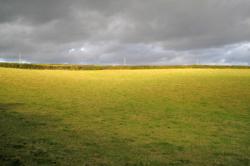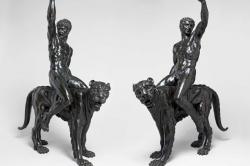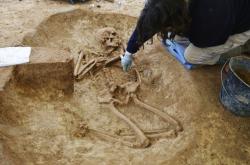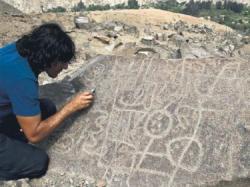INSTITUT SUPERIEUR D'ANTHROPOLOGIE
INSTITUTE OF ANTHROPOLOGY
ONLINE COURSES / COURS A DISTANCE
SPRING TERM : APRIL 2015
REGISTER NOW
GUATEMALA –  Xultun - Excavations at a more than 1,200-year-old Maya settlement in Guatemala suggest that ritual specialists made sacred books in a room where they also painted murals and astronomical tables on the walls. The new findings offer a rare glimpse of the people who created and wrote Maya books. At least two men buried near the mural room, located in a residential sector of an ancient Maya city called Xultun, took part in making bark-paper, stucco-coated codex books, say Boston University archaeology doctoral candidate Franco Rossi and his colleagues. One man was interred in an addition to the mural room constructed when the original chamber was filled in with limestone and mud, closing it down,Rossi’s group reports January 5 in American Anthropologist. “The mural room was sealed off and turned into this individual’s mausoleum,” Rossi says. Ritual specialists called taaj sit in a row at a royal ceremony. Researchers say the painting shows a high-ranking taaj (far right) who was buried next to the mural room.
Xultun - Excavations at a more than 1,200-year-old Maya settlement in Guatemala suggest that ritual specialists made sacred books in a room where they also painted murals and astronomical tables on the walls. The new findings offer a rare glimpse of the people who created and wrote Maya books. At least two men buried near the mural room, located in a residential sector of an ancient Maya city called Xultun, took part in making bark-paper, stucco-coated codex books, say Boston University archaeology doctoral candidate Franco Rossi and his colleagues. One man was interred in an addition to the mural room constructed when the original chamber was filled in with limestone and mud, closing it down,Rossi’s group reports January 5 in American Anthropologist. “The mural room was sealed off and turned into this individual’s mausoleum,” Rossi says. Ritual specialists called taaj sit in a row at a royal ceremony. Researchers say the painting shows a high-ranking taaj (far right) who was buried next to the mural room.
https://www.sciencenews.org/article/ancient-maya-bookmakers-get-paged-guatemala
ROYAUME UNI –  South Hams - Archaeologists in South Devon will use a rugby clubhouse and farming machinery during a search for prehistoric remains at a set of fields where a Bronze Age settlement was revealed by Google Earth and aerial photographic surveys.“The site had been identified as an area of potential by the Devon County Historic Environment Record team a number of years ago, but no further work had been considered until Howard’s discoveries,” says Sam Walls, the Director of the group leading the community excavation.A huge quantity and variety of material has been recovered from the site, which includes a range of post-medieval, medieval and prehistoric finds.
South Hams - Archaeologists in South Devon will use a rugby clubhouse and farming machinery during a search for prehistoric remains at a set of fields where a Bronze Age settlement was revealed by Google Earth and aerial photographic surveys.“The site had been identified as an area of potential by the Devon County Historic Environment Record team a number of years ago, but no further work had been considered until Howard’s discoveries,” says Sam Walls, the Director of the group leading the community excavation.A huge quantity and variety of material has been recovered from the site, which includes a range of post-medieval, medieval and prehistoric finds.
http://www.culture24.org.uk/history-and-heritage/archaeology/art515780-archaeologists-search-for-prehistoric-settlements-in-devon-fields-where-bronze-age-remains-were-revealed-by-google-earth
ITALIE –  Michelangelo - Two statues of muscular men riding panthers are now thought to be the only surviving bronzes of Michelangelo, the Fitzwilliam Museum at Cambridge University says. The artist behind the metre-high statues has long been a matter of speculation. The statues of two men, each holding an arm aloft in a gesture of salute, were attributed to the 16th-century Italian Renaissance artist based in part on a tiny detail from one of his students' drawings, the museum said. Last year Professor Paul Joannides, emeritus professor of art history at the University of Cambridge, connected the bronzes to a drawing by one of Michelangelo's apprentices now in the Musee Fabre in Montpellier, France. The apprentice's copy of some of Michelangelo's lost sketches includes a composition of a muscular youth riding a panther, which the museum said was very similar in pose to the bronzes. It was also "drawn in the abrupt, forceful manner that Michelangelo employed in designs for sculpture. This suggests that Michelangelo was working up this very unusual theme for a work in three dimensions," the museum said. The bronzes, which have spent over a century in relative obscurity, are now thought to be early works by Michelangelo, made just after he completed his marble statue of David and as he was about to embark on the Sistine Chapel ceiling, the museum said.
Michelangelo - Two statues of muscular men riding panthers are now thought to be the only surviving bronzes of Michelangelo, the Fitzwilliam Museum at Cambridge University says. The artist behind the metre-high statues has long been a matter of speculation. The statues of two men, each holding an arm aloft in a gesture of salute, were attributed to the 16th-century Italian Renaissance artist based in part on a tiny detail from one of his students' drawings, the museum said. Last year Professor Paul Joannides, emeritus professor of art history at the University of Cambridge, connected the bronzes to a drawing by one of Michelangelo's apprentices now in the Musee Fabre in Montpellier, France. The apprentice's copy of some of Michelangelo's lost sketches includes a composition of a muscular youth riding a panther, which the museum said was very similar in pose to the bronzes. It was also "drawn in the abrupt, forceful manner that Michelangelo employed in designs for sculpture. This suggests that Michelangelo was working up this very unusual theme for a work in three dimensions," the museum said. The bronzes, which have spent over a century in relative obscurity, are now thought to be early works by Michelangelo, made just after he completed his marble statue of David and as he was about to embark on the Sistine Chapel ceiling, the museum said.
http://www.abc.net.au/news/2015-02-02/bronzes-of-men-riding-panthers-are-by-michelangelo-says-museum/6062026
FRANCE –  Cormeilles en Parisis - Six sépultures individuelles, très bien conservées, datant de l’époque du Néolithique, ont été exhumées. Les fouilles archéologiques étaient menées préalablement à l’aménagement d’un rond-point, dans la Zac des Bois-Rochefort, au sud de Cormeilles. Ces ossements représentent « la première découverte du genre dans le Val-d’Oise », souligne Jean-Gabriel Pariat, archéo-anthropologue et responsable du Service départemental d’archéologie du Val-d’Oise, qui a mené les fouilles avec ses collègues de l’Institut national de recherches archéologiques préventives. Il s‘agit d’une découverte importante qui permettra de mieux connaître « ces sociétés lointaines du passé dont la plupart des coutumes sont encore méconnues », poursuit l’archéologue, « et qui va sans doute modifier certains livres sur l’histoire de Cormeilles », souligne le maire, Yannick Boëdec. Du 5 au 16 janvier, les archéologues ont fouillé minutieusement ce site cormeillais, grand comme un demi-terrain de foot. On était dans le cadre de l’archéologie préventive, car déjà il y a trois ans, on avait découvert ici une sépulture et un corps de ferme datant du IIe siècle. D’autres sépultures du Néolithique ont certes déjà été exhumées, mais ailleurs en Ile-de-France, et c’était il y a déjà dix ans, en Seine-et-Marne.
Cormeilles en Parisis - Six sépultures individuelles, très bien conservées, datant de l’époque du Néolithique, ont été exhumées. Les fouilles archéologiques étaient menées préalablement à l’aménagement d’un rond-point, dans la Zac des Bois-Rochefort, au sud de Cormeilles. Ces ossements représentent « la première découverte du genre dans le Val-d’Oise », souligne Jean-Gabriel Pariat, archéo-anthropologue et responsable du Service départemental d’archéologie du Val-d’Oise, qui a mené les fouilles avec ses collègues de l’Institut national de recherches archéologiques préventives. Il s‘agit d’une découverte importante qui permettra de mieux connaître « ces sociétés lointaines du passé dont la plupart des coutumes sont encore méconnues », poursuit l’archéologue, « et qui va sans doute modifier certains livres sur l’histoire de Cormeilles », souligne le maire, Yannick Boëdec. Du 5 au 16 janvier, les archéologues ont fouillé minutieusement ce site cormeillais, grand comme un demi-terrain de foot. On était dans le cadre de l’archéologie préventive, car déjà il y a trois ans, on avait découvert ici une sépulture et un corps de ferme datant du IIe siècle. D’autres sépultures du Néolithique ont certes déjà été exhumées, mais ailleurs en Ile-de-France, et c’était il y a déjà dix ans, en Seine-et-Marne.
http://www.gazettevaldoise.fr/2015/02/02/decouverte-archeologique-exceptionnelle-a-cormeilles/?utm_source=rss&utm_medium=rss&utm_campaign=decouverte-archeologique-exceptionnelle-a-cormeilles
FRANCE –  Jublains - Deux archéologues et des salariés du musée archéologique de Jublains ont procédé hier matin au grand nettoyage des thermes gallo-romains, situés sous l’église du village. Ce serait même peut-être un premier ménage réalisé depuis leur mise en valeur en 1974, sous l'oeil expert d'Anne Bocquet, archéologue au conseil général de la Mayenne. Pas de nouvelles découvertes pendant ce grand ménage d’hiver, mais les archéologues et historiens présents ont pu redécouvrir ce trésor, dans lequel finalement, personne ne rentre. « Nous avons le nez dessus, on se rend mieux compte du travail de qualité réalisé avec de superbes dalles de schiste, remarque Agathe Legros, directrice du musée archéologique départemental.
Jublains - Deux archéologues et des salariés du musée archéologique de Jublains ont procédé hier matin au grand nettoyage des thermes gallo-romains, situés sous l’église du village. Ce serait même peut-être un premier ménage réalisé depuis leur mise en valeur en 1974, sous l'oeil expert d'Anne Bocquet, archéologue au conseil général de la Mayenne. Pas de nouvelles découvertes pendant ce grand ménage d’hiver, mais les archéologues et historiens présents ont pu redécouvrir ce trésor, dans lequel finalement, personne ne rentre. « Nous avons le nez dessus, on se rend mieux compte du travail de qualité réalisé avec de superbes dalles de schiste, remarque Agathe Legros, directrice du musée archéologique départemental.
VIDEO = http://www.ouest-france.fr/archeologie-les-thermes-romains-de-jublains-nettoyes-3144511
PEROU –  Checta - The Peruvian Association of Rock Art (APAR) is searching to prove the mystery behind the recently discovered petroglyphs at Checta archaeological site. Petroglyphs located just three hours away from Lima were discovered that date back to five million years ago and experts claim they have great implications for Peruvian writing history, migration of groups, and ancient cultural periods. Archaeologist Gori Tumi Echevarría is out to prove the Checta petroglyphs hold a hidden message. The site, located in the Chiillon River of Santa Rosa de Quives, was initially discovered in 1925 by Monsignor Pedro Villar Córdova. Of significance today to archaeologist Echevarría are a series of 500 petroglyphs or “quilcas” that lie on the right bank of Alcaparrosa creek. Working since 2009, Echevarría has been analyzing the petroglyphs in form and style looking for answers. His findings thus far have allowed him to date four cultural periods of the Checta culture. The first period was defined by small holes in the rocks dating from 2500-2000 BC. The second period was focused on abstract figures with circles and sinuous lines, dating from 2200-1000 BC. The third period saw more semi-natural figures (1200-600 BC) and the final period saw symbolic representation with snake figures (800-200 BC). According to Echevarría’s hypothesis thus far, these petroglyphs may have links to the Amazon and could potentially provide insights to ancient pilgrimages of groups from the jungle down to the central coast.
Checta - The Peruvian Association of Rock Art (APAR) is searching to prove the mystery behind the recently discovered petroglyphs at Checta archaeological site. Petroglyphs located just three hours away from Lima were discovered that date back to five million years ago and experts claim they have great implications for Peruvian writing history, migration of groups, and ancient cultural periods. Archaeologist Gori Tumi Echevarría is out to prove the Checta petroglyphs hold a hidden message. The site, located in the Chiillon River of Santa Rosa de Quives, was initially discovered in 1925 by Monsignor Pedro Villar Córdova. Of significance today to archaeologist Echevarría are a series of 500 petroglyphs or “quilcas” that lie on the right bank of Alcaparrosa creek. Working since 2009, Echevarría has been analyzing the petroglyphs in form and style looking for answers. His findings thus far have allowed him to date four cultural periods of the Checta culture. The first period was defined by small holes in the rocks dating from 2500-2000 BC. The second period was focused on abstract figures with circles and sinuous lines, dating from 2200-1000 BC. The third period saw more semi-natural figures (1200-600 BC) and the final period saw symbolic representation with snake figures (800-200 BC). According to Echevarría’s hypothesis thus far, these petroglyphs may have links to the Amazon and could potentially provide insights to ancient pilgrimages of groups from the jungle down to the central coast.
http://www.peruthisweek.com/news-checta-petroglyphs-demonstrate-writing-dating-back-five-thousand-years-105163
GRECE –  – Serres -An ancient tomb hiding coins and pieces of gold was found on a municipal property, at a distance of 3km from Nea Zichni of Serres. The tomb was discovered during digging works of the municipal authorities for the construction of an open air theatre. The works stopped when the tomb was found. The police and archaeologists of the Ephorate of Antiquities of Serres were immediately asked to come to the spot. “There are many tombs in the area” the mayor of Nea Zichni, Andreas Dairetzis said and mentioned that graves were discovered in the past during construction works of the road Nea Zichni-Messorachi. An archaeologist of the Serres Ephorate of Antiquities received the grave goods. Soon their dating will be announced. According to the mayor of Nea Zichni the tomb seems to have been looted.
– Serres -An ancient tomb hiding coins and pieces of gold was found on a municipal property, at a distance of 3km from Nea Zichni of Serres. The tomb was discovered during digging works of the municipal authorities for the construction of an open air theatre. The works stopped when the tomb was found. The police and archaeologists of the Ephorate of Antiquities of Serres were immediately asked to come to the spot. “There are many tombs in the area” the mayor of Nea Zichni, Andreas Dairetzis said and mentioned that graves were discovered in the past during construction works of the road Nea Zichni-Messorachi. An archaeologist of the Serres Ephorate of Antiquities received the grave goods. Soon their dating will be announced. According to the mayor of Nea Zichni the tomb seems to have been looted.
http://www.archaeology.wiki/blog/2015/02/02/serres-tomb-coins-came-light/